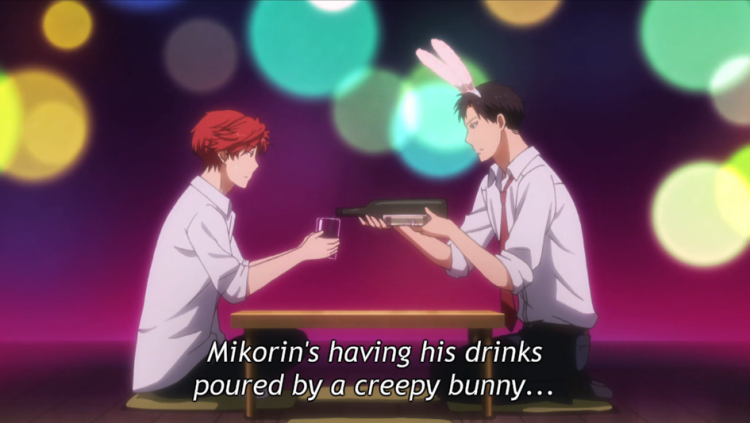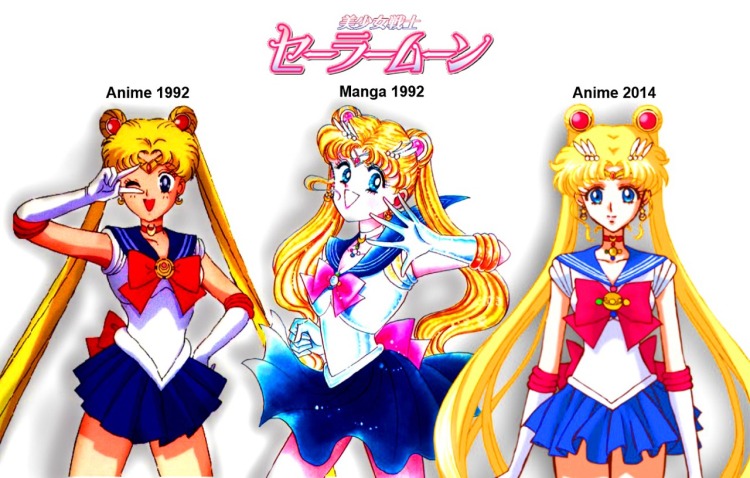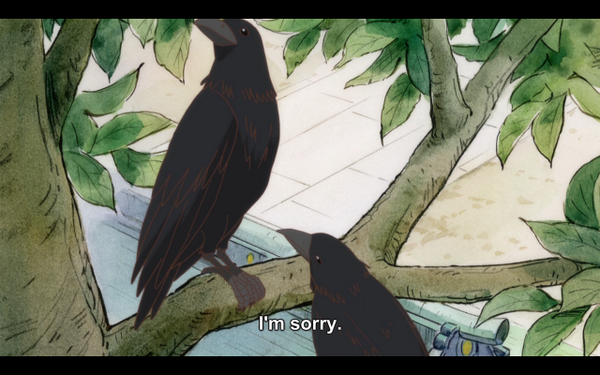So here is the long-belated follow-up to my post on the 2014 Summer Anime. Before getting to the original series, however, I’m going to take a look at some series that are continuing from the spring season. I didn’t plan to do a separate post on these, but I’ve noticed significant shifts in quality or tone in some of their second halves, so I figured they warranted their own post in examining how anime is doing this summer.
Of the series I watched this spring, three of them – Captain Earth; Haikyu!!; and the new Jojo’s Bizarre Adventure series, Stardust Crusaders – kept episodes up into the current season. I’ll discuss what I think has changed or stayed the same about each of them, along with the new Black Butler series, Book of Circus. Since I left it out of the “sequel series” posts, it’s included here – especially because I watched the original series recently enough for it to feel like a “continuation” to me anyway.
In rough reverse order of how much I’m enjoying each of them:
CAPTAIN EARTH: Up to Episode 19
Captain Earth is one heavily-anticipated series that sort of.. fell flat. It is and was never by any means bad, but it certainly didn’t live up to the high expectations for a Studio BONES coming-of-age mecha series written by Yoji Enokido, the brains behind RahXephon and FLCL. The first couple of episodes showed promise as each character was introduced, and then it went in circles with repetitive battles for its first half, making it hard for the viewers to care much about the conflict or the characters beyond the occasional slice-of-life moment among the four kids. And even those were ones we’d seen in plenty of other anime. Those first 12 episodes were quite the uphill battle, and I imagine most people dropped it if they weren’t invested enough in the creation team to hope it would improve.
Well, come summertime, Captain Earth is no longer a slog. The current arc, with the villains awakening more of their team in ordinary humans, resembles the “Rainbow Crystals” arc of the old Sailor Moon anime – contrasting these people’s (usually sad) ordinary lives with the dramatic personalities and goals they gain when awakened. They still don’t get the degree of development or sympathy that Sailor Moon pulled off with the Rainbow Crystal bearers, but they’re at least interesting enough to keep viewers tuning in. The trade-off, of course, is that protagonist Daichi has become a bystander in his own story as the focus has shifted elsewhere. Even Hana has become a more interesting character than he ever was as her backstory and reason for being were explored more in the last few episodes, and it’s hard to see why Daichi is the “main character” in the first place. The last couple of episodes at least seem to nod at exploring his psyche, and how it’s been affected by the enormous role he’s been given as the titular “Captain Earth”. But it’s just that: nods. Nothing substantial has happened. Akari, too, has only had tilts in the direction of her being more than a quirky hacker who sees herself as a magical girl, though those “tilts” still seem to hint at more than what Daichi’s been given lately.
At least with Captain Earth we can enjoy the high production values expected with a BONES effort. Not every series BONES has done is good, but it always looks good. It’s just hard to care much for that when the material is so lacking. Enokido has shown a real knack for character-writing and a depth of understanding of the adolescent mind in other series, like Ouran High School Host Club. Where is it this time?
HAIKYU!!: Up to Episode 19
Haikyu!!, on the other hand, is a show I didn’t go in with as high of expectations. I’m always a bit hesitant with sports anime; I’m terrible at sports myself and only been able to get into watching a few of them. Free! was the only one I watched before this, but it was more about the characters and their relationships with each other and the sport, than the actual competitions; plus, swimming happens to be the one sport I’m good at and where I’ve actually practiced.
Well, if Haikyu!! is any indication, “characters and their relationships with each other and the sport” is the rule for most sports anime. At least in the first half of it, which started with Hinata as a middle-schooler volleyballer who’s middling on talent, but high on spunk. Even when his team disbanded after losing in a tournament, he continued to practice spiking with anyone who would join him. The end of the episode then moves to his high school, where he finds out that the main player of the team that kicked them out of the competition is now his own teammate. The first string of episodes focuses on their initial antagonism developing into friendship, as well as the other characters on the team and their own relationships with volleyball.
The second season has slumped a bit, as it’s moved its focus to tournament matches. It’s done a little bit of the character-focus with other teams, and the Karasuno (main characters’ school) characters’ histories with each. For example, Karasuno’s victory over Dateko – whose defeat of them the previous year triggered enough anxiety in Karasuno’s ace Asahi to make him leave the sport – was a moral high point stretched out over several episodes. And one episode focused on all the teams who lost in the first round, including the one Karasuno defeated, and their own girls’ team. While those were interesting, overall it’s kind of hard to keep as closely-focused if you aren’t yourself fascinated with the sport of volleyball.
The first half of the series showed why sports anime is picking up speed with the success of Free! Even if you yourself are not an athlete, you can probably relate to the feeling of being a part of a team, and of practicing toward a larger goal. As someone who did a lot of band and orchestra in high school, I see a lot of my teenage experiences mirrored in sports stories – especially with the similarities between practicing an instrument and a sport. But when the focus is just matches and ball-hitting action, it will lose a few people who aren’t there just for that.
Well, at least the series continues to be eye-poppingly animated, and chockful of humor and heart. I know that that will keep me watching until the very end, even if I don’t find the curve of a particular serve all that engaging.
BLACK BUTLER: BOOK OF CIRCUS: Up to Episode 4
Black Butler started off its new series in traditional “recap” fashion – showing a typical episode of the original series to get viewers up to speed. Since it was my first experience with the franchise at all, I found it interesting, enough to get me to watch the original, but it was probably dull and unnecessary to those who are familiar with it and just want to jump into the circus-ing. Even the second episode, when the plot started in earnest, still featured reappearances of some favorite characters from previous arcs. (Not that I mind when they’re my favorite characters in the whole series.)
But now that that’s underway, this new series is starting to find its feet. The “Book of Circus” is many manga fans’ favorite arc, or so I’ve heard. Like most of the show, it involves creepy supernatural hijinks in the form of a crime for Ciel to solve: a traveling circus with a Pied-Piper-esque affect on local children. It’s good to see the series that’s infamous for “losing its way in order to please the shippers fanbase”, get back on track – returning to the heart of the series, the original manga that inspired it and that’s still running. If the anticipated “Book of Murder” specials are any indication, it looks like it will continue to adapt new manga arcs as long as there is more fan money to be spent. (And based on all the Black Butler cosplays and merch I saw this past weekend at Otakon, there will be for quite a while.)
The downside of having a built-in fanbase is the production team doesn’t feel the need to put as much effort into this latest installment. The animation took a noticeable step down from the first series, at least. But in a reverse of what I said about Captain Earth, this only matters so much if the material is strong. And so far, it’s easy to see why this arc is such a fan-favorite, from the unsettling mystery behind it all, to a colorful new cast of characters associated with the titular circus, to all the comedic potential of forcing privileged Ciel to live in a tent as a vagabond circus performer. There’s a lot to work with here, and the first three episodes of “plot” have shown a lot of potential.
Best, perhaps, is the sequence at the end of episode four, where the circus’s hypnotic effects on children is first revealed to the viewer – from the child’s perspective. The sequence depicting her fairy-tale hallucination and contrasting it with the actual action shows this team still has the potential for good visuals when they want to use it. Let’s hope they do.
JOJO’S BIZARRE ADVENTURE: STARDUST CRUSADERS: Up to Episode 19
I came into Stardust Crusaders a complete newbie to the franchise, not having read any of the manga or seen the 2012 anime adaptation of the previous two arcs (Phantom Blood and Battle Tendency). I was told it didn’t matter, that I’d still have plenty of fun with it. I doubted this pretty hard, but decided to give Jojo’s a chance anyway – and it turned out they were 100% right.
As something of an affectionate send-up of shonen battle anime, Stardust Crusaders is constant, breakneck action and fun from start-to-finish. It’s the one series from spring that hasn’t lost my interest at all – and in fact, even with the summer class added in, it’s the show I most look forward to watching every week. On top of the fact that I love travel stories (the early parts of Stardust Crusaders see the characters trekking across Asia on their way to face Dio in Egypt), each new location features even crazier enemies and Stands to battle. You can’t stop watching to see what bizarre new threat they’re going to face in the next country. It’s hard to see how a series could continually top itself in weirdness when one of its early episodes showed them fighting an orangutan on a mirage-boat – but Jojo’s can.
What’s more, it has a fun, colorful cast of characters – especially gruff protagonist Jotaro Kujo, flamboyant-but-dim Frenchman Jean-Pierre Polnareff, and grandpa adventurer Joseph Joestar. (As an American, Joseph gets the series’ most ridiculous lines, with exaggerated Engrish “OHHHHHH NOOOO!”s and “OHHHHH SHIIIIT!”s every time anything goes wrong. It’s enough to make one shriek with glee when they find out that he’ll be the focus of an enemy’s attacks in the next episode.) It’s hard to think of a single thing that isn’t engaging about this show, and indeed, I’m hard-pressed to think of any episode where it falls flat. It’s kept me on the edge of my seat through its entire run – again, even as a franchise virgin.
This excellence includes the production. While thick-lined character designs could be distracting in series like Attack on Titan, with Jojo’s it works, due to the art style in general emulating American comic books. It’s always bright and saturated, except when it shouldn’t be (as in a Pakistani town beset by a fog Stand), and a feast for the eyes. The music is also top-notch, varying from weird atonal piano and string slices in unsettling moments, to brassy, overwrought jazz for climactic battle scenes. Whatever it is, it always fits the scene perfectly and amplifies its mood, while also feeling like it couldn’t belong in any other anime. Everything about Jojo’s is special, and that’s what makes it an experience like no other.
Up next: The original summer 2014 series! Will include Aldnoah Zero, Blue Spring Ride, Love Stage!!, Monthly Girls’ Nozaki-kun and Terror in Resonance!














